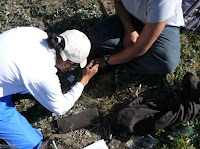If I studied porcupines, I might investigate whether or not they have a sense of vengeance.
It began, innocently enough, with trying to save time in the morning. We get up quite early in the morning when we are trapping the marmots because we want to get out to a colony, set and bait traps, and get off the site well before the marmots are up (usually around sunrise). We use a type of horse feed as bait and carry it around with us in plastic containers. Normally, if we are leaving from the lab in the morning anyway, we just grab bait when we stop by. If it is easier to leave from our cabin, we will sometimes bring the trapping materials (including bait) to our cabin the night before to speed things up in the morning.
Well, this one time, we had a mouse problem in our cabin (see “High altitude brownies”, and you may begin to guess why), and we thought it would be better to leave the bait outside, so as not tempt more mice inside. At the time, we were in Avery cabin, which has a little mudroom, basically a small sheltered porch between the cabin door and wood pile, where you can leave your muddy boots and gear. Great, we thought, we can leave the bait out there. At this time, we also had a porcupine that liked to hang out in the wood pile. Here he/she is:

In retrospect, we really should have seen what was coming. Porcupines do, after all, have very large teeth for gnawing. So unsurprisingly, the next morning we found: a large hole chewed in the bait container, partially eaten bait, and a few porcupine quills scattered in the mudroom. Oops, ok, so we learned our lesson and realized it was better to keep the bait inside after all, and that’s what we did that night. The morning after that, we got up, got ready, and opened the door to the mudroom. The first thing that hit us was the stench. WHAT was that?? Looking down we spied: a few scattered porcupine quills, a puddle or foul-smelling liquid, and some poop. Not to attribute a human sense of revenge to the porcupine or anything, but it did seem like suspicious timing.
Not the culprit, but another porcupine ambling peacefully by a marmot colony. (In fact, in this case, I was the one harassing it with my picture-taking. All photos: Tina W. Wey)








































